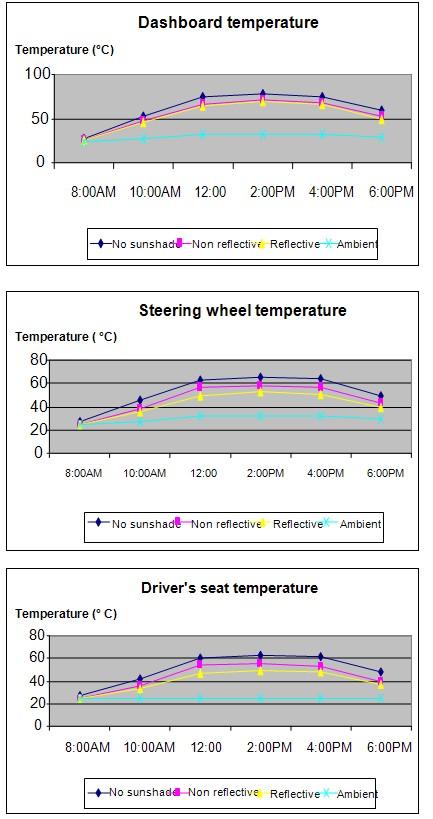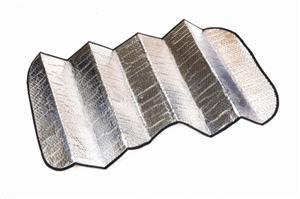| Complexity level: | 5 |
| Project cost ($): | 100 |
| Time required: | 1 day to prepare, 1 day for the science project experiment |
| Material availability: | Easily found |
| Safety concerns: | Ensure that cars are driven by persons with valid driving licenses. |
Hypothesis
Cars with reflective sunshades have the lowest temperature inside the car.
Overview
Sunshade
The interior of a car that is parked outdoors on a hot sunny day can reach temperatures of up to 90 °C. This drastic increase temperature is caused by a combination of hot temperatures outside the car and lack of proper ventilation for the hot air to escape out of the car. Utraviolet radiation from the sun also enters through the windscreen and heats up the air in the car. The front windscreen also sometimes acts like a magnifying glass, intensifying the sun rays, and make the car interior hotter on sunny days.
These extreme conditions will not only cause a lot of discomfort to the driver and his passengers, they can also damage the interior of the car. The two methods that are normally used to reduce the build up of temperature in the car are tinting the car windows or using sunshades. Tinting the window involves permanently installing a film on the window of the car. In some countries, this is not permitted by law.
Sunshades on the other hand, are removable. They are very effective in blocking the sun’s rays from entering through the car’s windshield. Sunshades are able to prevent and block about 99% of the sun’s ultraviolet rays from entering inside the car.
Scientific Terms
Materials
The materials required for this science fair project:
- 3 cars – of thesame make and model, interior and color
- 1 non-reflective sunshade
- 1 reflective sunshade
- 1 infrared thermometer
Procedure
1. For this science project, the independent variable is the type of sunshade used – no sunshade, a non-reflective sunshade and a reflective sunshade. The dependent variable is the temperature on the dashboard, the steering wheel and the seat. This is determined using an infrared thermometer. The constants (control variables) are the color of the car, the outside temperature, the make and model of the car.
2. The 3 cars are first checked to ensure their colors, interior conditionsand their model are the same. The cars are then parked outside under the sun and checked using the infrared thermometer to ensure that the temperatures inside all the 3 cars are similar.
3. Once the internal temperatures of the 3 cars are verified as being the same, the cars are prepared for testing on the next day as follows :
a. The first car is parked in the sun without any sunshade.
b. The second car is parked in the sun with a non-reflective sunshade under the windscreen.
c. The third car is parked in the sun with a reflective sunshade under the windscreen.
4. On the next day, the temperatures of the cars are observed for 10 hours from 8:00 am to 6:00 pm. The temperatures dashboard, steering wheel and the driver’s seat are checked once every 2 hours using the infrared thermometer. All the temperatures are recorded in the table below.

Results
It was observed that the car which had been installed with the reflective sunshade had the lowest cabin temperature,
followed by the car with the non-reflective sunshade. The car without a sunshade had a temperature that was higher than than the other cars of between 6 °C and 8 °C.
|
Location measured |
Car with sunshade |
Temperatures measured at different points and time (°C) |
|||||
|
8:00AM |
10:00AM |
12:00 Noon |
2:00PM |
4:00PM |
6:00PM |
||
|
Dashboard |
No sunshade |
26.7 |
51.9 |
74.3 |
77.4 |
75.2 |
58.9 |
|
Non reflective |
24.8 |
47.5 |
66.8 |
71.3 |
68.3 |
52.7 |
|
|
Reflective |
24.6 |
45.9 |
64.2 |
68.9 |
65.3 |
49.7 |
|
|
Steering wheel |
No sunshade |
26.7 |
45.7 |
63.2 |
65.2 |
64.1 |
49.7 |
|
Non reflective |
24.8 |
38.5 |
56.8 |
58.1 |
56.3 |
42.6 |
|
|
Reflective |
24.6 |
35.7 |
49.4 |
52.5 |
50.9 |
39.7 |
|
|
Driver’s seat |
No sunshade |
26.7 |
41.8 |
60.9 |
63.1 |
61.2 |
47.6 |
|
Non reflective |
24.8 |
36.1 |
53.8 |
55.8 |
52.7 |
39.7 |
|
|
Reflective |
24.6 |
33.5 |
46.9 |
49.6 |
47.6 |
36.5 |
|
|
Exterior temperature |
24.5 |
24.5 |
24.5 |
24.5 |
24.5 |
24.5 |
The graphs below represent the results of our science experiment:

Conclusion
The hypothesis that cars with reflective sunshades have the lowest interior temperature, is proven to be true.
The use of sunshades inside a car on bright sunny days hels to reduce temperatures by about 8 to 10 °C. They certainly make quite a difference! Besides helping to keep the cabin at comfortable temperatures, they also help to protect our car’s interior from discoloration and cracking.
Also consider
What would happen if the experiment were to be repeated by using cars with tinted glass?
The experiment can also be repeated by using cars with different colors and sunshades.
References
Is your car an oven? - http://www.roadandtravel.com/autonewsandviews/2005/sunshades.htm
Cool your wheels - http://editorial.autos.msn.com/article.aspx?cp-documentid=434615

